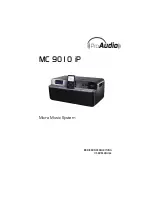
Page 44
Voyager OS User’s Manual - Appendices
Page 45
Voyager OS User’s Manual - Appendices
The Oscillator is the starting point of Subtractive Synthesis, for it is here that the initial sound is created. The
oscillator creates electrical vibrations which function in a manner similar to the strings of a guitar; they create the
signal source that the rest of the system will use to modify and shape the sound. The key oscillator parameters
are pitch and waveform.
The pitch of the oscillator is primarily determined by the keyboard, which creates specifi c pitches based on an
equal-tempered scale (more about the keyboard later).
The waveform determines the harmonic richness of the audio signal. There are four basic waveforms common
to most synthesizers: sawtooth, square, triangle and sine.
The sawtooth wave is the richest sounding of the four waves. It contains all
of the harmonics, and has a bright, buzzy sound. Sawtooth waves are ideal
for brass and string sounds, bass sounds and rich accompaniments.
The square wave possesses a hollow sound compared to the sawtooth,
owing to the fact that it contains only odd harmonics. This hollow
characteristic is ideal for distinctive lead and sustained (pad) sounds.
An interesting aspect of the square wave is that the waveshape can be
changed to make the top and bottom parts asymmetrical, creating a pulse
wave. By changing the shape of the wave, new harmonics are introduced.
Pulse waves are ideal for creating clavinet-like sounds, but are also useful
for creating lush pads. Many synthesizers allow you to dynamically control
the shape, or ‘width’ of the pulse wave using modulation sources such as a
low frequency oscillator (LFO). This type of waveform control is known as
‘pulse width modulation’, or PWM.
The Subtractive Synthesis Model
Содержание Voyager Old School
Страница 10: ...Page 12 Voyager OS User s Manual The Basics TheVoyager OS Modulation Buss...
Страница 55: ...Page 57 Voyager OS User s Manual...
Страница 56: ...Page 58 Voyager OS User s Manual...















































